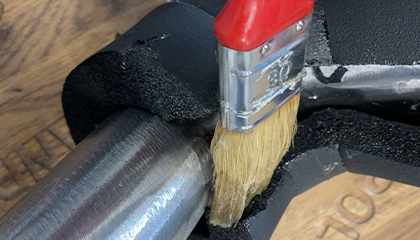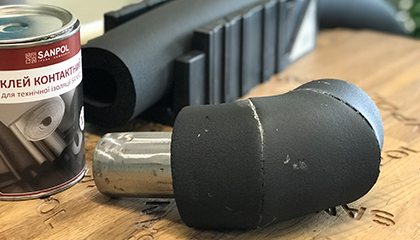Practice shows that the thermal insulation of the pipeline, installed in accordance with technological requirements, is capable of providing not only a serious reduction in heat energy losses, but also its better preservation, and, accordingly, an increase in its useful life. Thus, it is obvious that the installation of thermal insulation of pipelines should be carried out in accordance with the current rules, standards and regulations.
 There are two main ways to install Armacell Oneflex rubber insulation by gluing them together and to the surface of pipelines or a tank:
There are two main ways to install Armacell Oneflex rubber insulation by gluing them together and to the surface of pipelines or a tank:
- thermal insulation tubes, as well as in some cases sheets are tightly glued at the edges to the insulated object and glued together at the ends, as well as in places of longitudinal cuts and joints;
- thermal insulation sheets (rolls) are glued to the surface of the object over the entire area and glued together with the ends.
Recommendations for the use of glue
- Use a clean brush with short, stiff bristles. On large surfaces, to speed up the glue application process, a spatula or a paint roller (not made of foam material such as foam rubber) or an adhesive nozzle can be used.
- Apply the adhesive in a thin and even layer on both surfaces to be glued.
 If the Armacell Oneflex thermal insulation needs to be glued to another material (for example, metal), then the glue is applied first to the insulation, and then to another cleaned surface.
If the Armacell Oneflex thermal insulation needs to be glued to another material (for example, metal), then the glue is applied first to the insulation, and then to another cleaned surface.- Let the glue dry a little! The time required for drying depends on the surrounding conditions. The correct time required for bonding can be determined by a "finger test": touch the adhesive surface with your finger, if it does not stick to the surface and the surface itself does not seem sticky, then the seam can be glued. The maximum bonding force is achieved by connecting two properly seasoned surfaces.
- The surfaces to be glued together should be pressed against each other, not attracted. In the case of insulation installed outside, do not leave the glued seams unprotected from the sun. When working outdoors, place the seams in places inaccessible to sunlight.
 If the edges of the two segments of insulating materials in the seam are tightly pressed against each other, and applying glue separately to each edge of the seam is not possible, then the "wet gluing" method should be used. The edges of the materials need to be slightly pushed apart, and the resulting gap carefully smeared with glue, so that it covers the entire surface of the edges of the materials with a thin and even layer. Then – press the glued surfaces to each other. In this case, it is not necessary to wait for the glue to dry.
If the edges of the two segments of insulating materials in the seam are tightly pressed against each other, and applying glue separately to each edge of the seam is not possible, then the "wet gluing" method should be used. The edges of the materials need to be slightly pushed apart, and the resulting gap carefully smeared with glue, so that it covers the entire surface of the edges of the materials with a thin and even layer. Then – press the glued surfaces to each other. In this case, it is not necessary to wait for the glue to dry.- To clean the tool, contaminated metal surfaces and talc-coated surfaces, use a cleaner.
- After the end of the installation with the use of glue, at least 36 hours must pass before the start of operation.